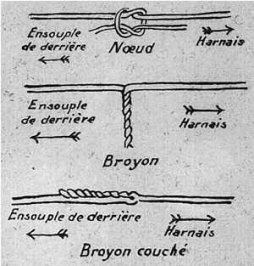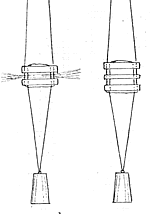- Home
- Resurrection ▾
-
Learn ▾
- Free library
- Glossary
- Documents
- Initiation
-
Shaped fabrics
- Introduction
- Popularization
- Definitions
- Le métier de façonné
- Principes du façonné
- Mécaniques de façonné
- Le jeu des crochets
- Les cartons
- Chaîne des cartons
- Mécanique 104 en détail
- Pour en finir
- Montage façonné
- Empoutage 1/3
- Empoutage 2/3
- Empoutage 3/3
- Punching, hanging and dip
- Autres façonnés
- Façonnés et Islam
-
Cours de tissage 1912
- Bâti d'un métier
- Le rouleau arrière
- Les bascules
- Formation du pas
- Position de organes
- Mécanique 104 Jacquard
- Fonctionnement 104
- Lisage des cartons
- Le battant du métier
- Le régulateur
- Réduction et régulateur
- Mise au métier d'une chaîne
- Mise en route du métier
- Navettes à soie
- Battage
- Ourdissage mécanique
- Préparation chaînes et trames
- Equipment ▾
- Chronicles ▾
- Fabrics ▾
- Techniques ▾
- Culture ▾
- Language ▾

For the second yarn as well as for all those of the piece, it proceeds in the same way by choosing the stitches on the healds according to the order indicated by the arrangement of the fabric to be executed.
The way of passing the threads through the meshes depends on the kind of meshes:
In the metal mesh or the knitted cotton knitted or knitted or knitted Swiss stitches a small slip is used.In the so-called sliding meshes or meshes of Lyons, the threads simply pass by a small turn of hand with the fingers of the left hand.
2 / - Combing stitching:
When the wrapping is finished, all the wires are passed through the meshes of the shed, the stitching is carried out in a comb, which is carried out by two persons.
The comb is suspended by its two extremities at the upper smoothness of the last rail, then slightly inclined at the rear.
The first person called the donor selects the threads that must be placed in the same tooth of the comb, while the second person called the stitcher slips a small flat pass between the teeth of the comb. The threads chosen at the shed are attached to the saddle that the stitcher removes by pulling the threads hanging on it between the teeth of the comb. The stitcher keeps the threads of the piece as they pass through, placing them in a suitable manner under the thumb of the left hand so that they do not interfere with the passing of the passage, Empty teeth or double teeth are produced in the width of the comb. The wires are tied in small packages so that they can not escape from the comb.
3 / - Twisting:
Twisting is the operation by which a new piece is added to a finished piece by wire, this operation avoiding a resetting and a comb stitching.
The twisting operation takes place whenever the number of wires of the new piece matches that of the finished part and the fabric to be executed can be obtained with the same number of healds and the same combination of remounting Than the fabric previously executed. Twisting takes less time than remounting is usually less expensive.
In order to be able to twist, the loom must be in perfect condition at the end of each piece, ie leave a sufficient length of chain of about 80 cm, and repair the broken wires carefully and when It is possible to re-open the entire piece again so that the threads are in their proper position at the spool, in order to avoid mistakes of twisting, which would be necessary and difficult to repair later.
The preparation of the twisting is done in the following manner: the first step is to extend the folded chain on the roller and then the threads are separated at the reverse to be able to place in the place of the enclosing cords 2 large rods known as the rods to twist.
These rods are supported on one side by a large rope, each of the ends of which is attached lengthwise to the foot of the loom and on the other side by a hook suspended from a rope attached to the estase and comprising 2 rings in which the canes are passed, this kind of support is called a "crown".
The mistakes that can occur in twisting are as follows: if the leafroller picks up two successive yarns from the comb and twists them with only one of the new part, a defect is designated in this case Under the name of marriage, this fault must be avoided because it will be two threads missing the whole length of the piece and which the worker will be obliged to replace. The spruce budworm must constantly heal the threads as it chooses and if it meets a single one ie several threads on the same cane it must separate them and replace the one that is missing. When the new piece presents itself, if there is no broken thread in the chain, to append it, it places the missing wire in command with a pin.
When the arrangement of the new piece is not exactly in conformity with that of the old one, it sometimes happens that it is obliged to overcome the threads of the remiss and the comb if there is too much or vice versa, If the shed has empty stitches.
For the same chain count, the width is changed by changing the comb reduction or the comb stitching, in this case the comb is repacked after passing the twists in front of the shed.
Once the first stitch is chosen, she fetches the first thread on the twisting sticks with her right hand as close as possible to the shed body, pulls it from the servant and passes it through the first stitch, and then immediately Is attached to the valet, a small device to the left of the remaster to hold the threads as they pass through the meshes.
Creation of a warp
When a loom is loomed, it is presented in two different cases: When the loom is first assembled and when the fabric has already been executed with an employed organization.
In the first case, the chain is put into the loom by means of a re-tacking and a comb stitching. In the second case, it is done by twisting a few times, followed by a comb stitching.
Refinishing, comb stitching and twisting:
1 / - Remounting:
The term "resetting" refers to the operation of passing all the wires of the chain through the meshes of the healds intended by their movement to cause the opening of the pitch. The order in which the yarns are put back on the healds differs according to the kind of fabric to be executed, the number of yarns in the warp. The various remissions employed are 6 in number:
Remission
Amalgamated remission
Return or spike restoration
Resetting into several bodies
Remission interrupted
Combined remission
Whatever the type of remounting, the operation of the passage of the wires always takes place in the same way. This remounting operation is carried out most often outside the loom, the roller and the shed being supported by an easel suitable for this type of work.
The remounting can also be carried out on the craft itself, but this involves the forced stop of this craft for a few days.
This preparatory operation for weaving is carried out by a single person who proceeds in the following manner: firstly, he takes the wire feed which is at the beginning of the unwound part of the beam and passes in place of the beads d Sends two big rods to twist and then divides the chain into 6 or 8 small packages that it twists and knots in the shape of a loop.
Remounting always starts with the left thread. She seizes the first package of yarn and makes it cross under the body of remisse to place it in an apparatus called servant formed of two small boards that encloses the mass of threads. With its hands free the chopper selects the stitch in which it must place the first thread which is generally situated on the first rail and the one from behind, ie closest to the chain roller and furthest from the remaster.


Practical hand weaving course
Lyon Municipal Weaving SchoolProfessor A.CREPT - Year 1912-1913
The handwritten course has been copied by us.This hand weaving course on looms was used until the 1980s.
